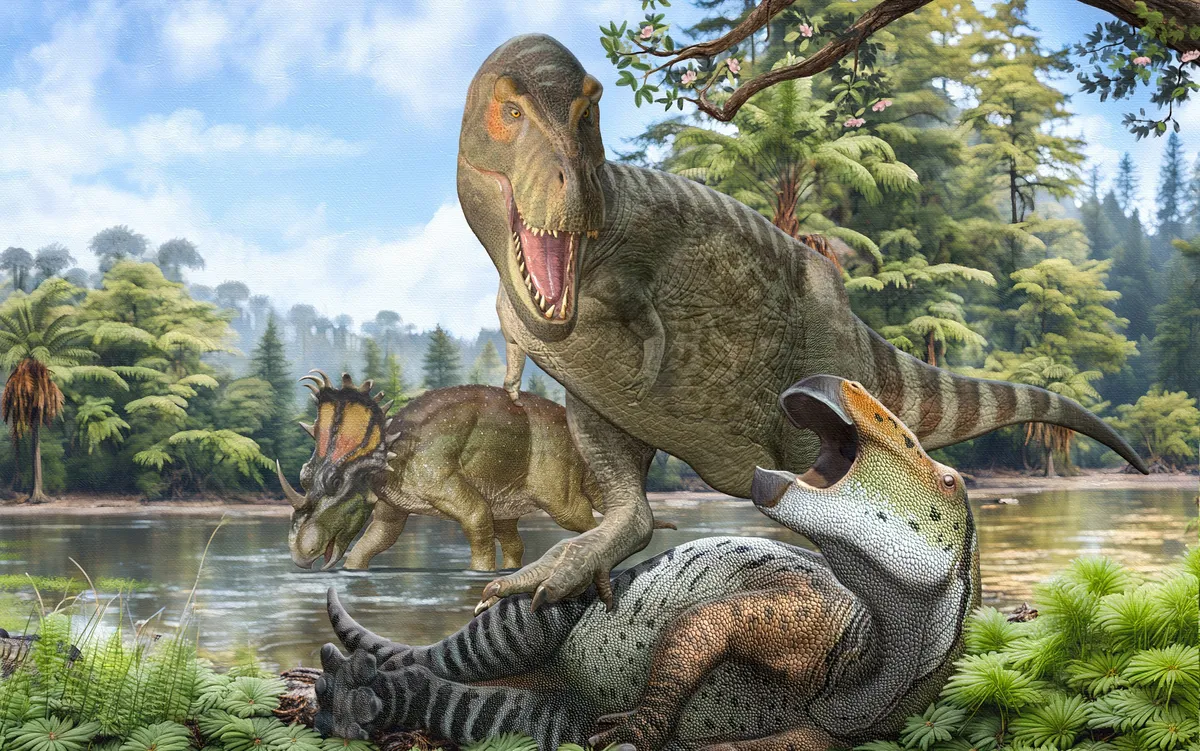
The Tyrannosaurus rex is one of the most iconic dinosaurs, known for its massive size and ferocious nature. Recent research led by UCL scientists reveals that the evolutionary journey of T. rex began in North America, but intriguingly, its direct ancestor migrated from Asia over a land bridge connecting the continents more than 70 million years ago. This groundbreaking study, published in Royal Society Open Science, sheds light on the origins and evolutionary adaptations of not only T. rex but also its relatives, the tyrannosaurids and megaraptors.
The study highlights a significant correlation between the rapid growth of tyrannosaurids and another group known as megaraptors and a cooling trend in global climate following a peak in temperatures approximately 92 million years ago. This cooling may have favored T. rex and its relatives, suggesting they were better adapted to cooler climates than many other dinosaur species of the era. The adaptation could have been due to the presence of feathers or a more warm-blooded physiology, which would have helped them thrive in less temperate conditions.
The research team included experts from several prestigious institutions, such as the University of Oxford, Pittsburgh, Aberdeen, Arizona, Anglia Ruskin, Oklahoma, and Wyoming. Lead author Cassius Morrison, a Ph.D. student at UCL Earth Sciences, remarked on the ongoing debate surrounding the geographic origin of T. rex. Paleontologists have long been divided on whether its ancestors originated in Asia or North America. The research indicates that T. rex's 'grandparents' likely traveled from Asia to North America, crossing the Bering Strait, which connected present-day Siberia and Alaska.
While numerous T. rex fossils have been discovered in North America, the researchers posit that the fossils of its direct ancestor may still be hidden in Asia. The study refutes a previous claim that a T. rex relative known as Tyrannosaurus mcraeensis, found in New Mexico, predated T. rex by three to five million years. The researchers argue that the dating of this fossil was not reliable, suggesting the evolutionary timeline of T. rex remains intact.
The study also investigated the evolutionary pathways of megaraptors, which are often considered one of the most enigmatic large, meat-eating dinosaurs. Unlike T. rex, megaraptors developed slender heads and long arms, with claws measuring up to 35 centimeters (14 inches) in length. The findings indicate that megaraptors likely originated in Asia around 120 million years ago before spreading to Europe and throughout the ancient supercontinent of Gondwana, which included regions that are now Africa, South America, and Antarctica.
Both the tyrannosaurids and megaraptors exhibited remarkable growth during the same period as the global climate cooled after the Cretaceous Thermal Maximum. This growth spurt followed the extinction of the carcharodontosaurids, which left a void at the top of the food chain. The researchers suggest that tyrannosaurs, including T. rex and megaraptors, may have been better suited to exploit the cooler temperatures compared to rival dinosaur groups.
At the end of the age of dinosaurs, T. rex could weigh up to nine metric tons, comparable to a large African elephant. Meanwhile, megaraptors reached impressive lengths of 10 meters. Co-author Charlie Scherer, an MSci Earth Sciences graduate and aspiring Ph.D. student at UCL, stated that the findings illuminate how the largest tyrannosaurs emerged in North and South America during the Cretaceous and why they attained such gigantic sizes. He noted that their growth was likely a response to the extinction of the equally large carcharodontosaurid theropods, which had previously dominated the ecosystem.
Additionally, Dr. Mauro Aranciaga Rolando from the Bernardino Rivadavia Natural Sciences Argentine Museum in Buenos Aires emphasized that megaraptors were once part of a diverse dinosaur community. As the Cretaceous period progressed and the continents drifted apart, these predators became increasingly specialized, adapting to specific environments. While megaraptors were eventually outcompeted by tyrannosaurs in Asia, they evolved into apex predators in regions like Australia and Patagonia, showcasing the dynamic evolutionary history of these remarkable creatures.